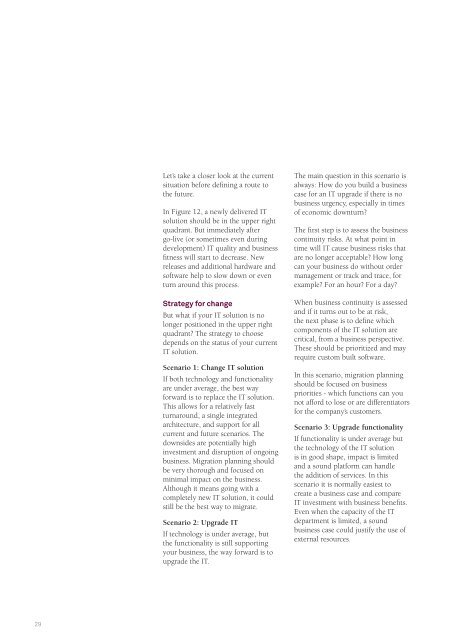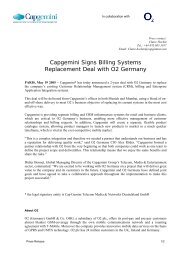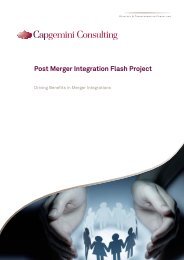Transportation Management Report 2011 - Capgemini
Transportation Management Report 2011 - Capgemini
Transportation Management Report 2011 - Capgemini
You also want an ePaper? Increase the reach of your titles
YUMPU automatically turns print PDFs into web optimized ePapers that Google loves.
29<br />
Let’s take a closer look at the current<br />
situation before defining a route to<br />
the future.<br />
In Figure 12, a newly delivered IT<br />
solution should be in the upper right<br />
quadrant. But immediately after<br />
go-live (or sometimes even during<br />
development) IT quality and business<br />
fitness will start to decrease. New<br />
releases and additional hardware and<br />
software help to slow down or even<br />
turn around this process.<br />
Strategy for change<br />
But what if your IT solution is no<br />
longer positioned in the upper right<br />
quadrant? The strategy to choose<br />
depends on the status of your current<br />
IT solution.<br />
Scenario 1: Change IT solution<br />
If both technology and functionality<br />
are under average, the best way<br />
forward is to replace the IT solution.<br />
This allows for a relatively fast<br />
turnaround, a single integrated<br />
architecture, and support for all<br />
current and future scenarios. The<br />
downsides are potentially high<br />
investment and disruption of ongoing<br />
business. Migration planning should<br />
be very thorough and focused on<br />
minimal impact on the business.<br />
Although it means going with a<br />
completely new IT solution, it could<br />
still be the best way to migrate.<br />
Scenario 2: Upgrade IT<br />
If technology is under average, but<br />
the functionality is still supporting<br />
your business, the way forward is to<br />
upgrade the IT.<br />
The main question in this scenario is<br />
always: How do you build a business<br />
case for an IT upgrade if there is no<br />
business urgency, especially in times<br />
of economic downturn?<br />
The first step is to assess the business<br />
continuity risks. At what point in<br />
time will IT cause business risks that<br />
are no longer acceptable? How long<br />
can your business do without order<br />
management or track and trace, for<br />
example? For an hour? For a day?<br />
When business continuity is assessed<br />
and if it turns out to be at risk,<br />
the next phase is to define which<br />
components of the IT solution are<br />
critical, from a business perspective.<br />
These should be prioritized and may<br />
require custom built software.<br />
In this scenario, migration planning<br />
should be focused on business<br />
priorities - which functions can you<br />
not afford to lose or are differentiators<br />
for the company’s customers.<br />
Scenario 3: Upgrade functionality<br />
If functionality is under average but<br />
the technology of the IT solution<br />
is in good shape, impact is limited<br />
and a sound platform can handle<br />
the addition of services. In this<br />
scenario it is normally easiest to<br />
create a business case and compare<br />
IT investment with business benefits.<br />
Even when the capacity of the IT<br />
department is limited, a sound<br />
business case could justify the use of<br />
external resources.















